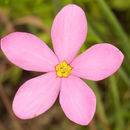en
names in breadcrumbs


USA: AL , AR , CT , DE , FL , GA , IL , IN , KS , KY , LA , MD , MA , MI , MS , MO , NJ , NY , NC , OH , OK , PA , SC , TN , TX , VA , WV , DC (NPIN, 2007)
Native Distribution: S. Ont., s. MI & WI, s. to n. FL, TX & extreme s.e. KS (NPIN, 2007)
Flowers are fragrant and rose-pink with a yellow center and appear on stem tips. The 5 petals of each flower are united in a single tube, which daily flares open to reveal the yellow of the petal bases as a star in the center, and then closes at night. (Wells et al, 1999) Flowers are sparse on the panicled (loose, diversely branching flower cluster) branches. The corolla is 4-parted and rose pink with a yellowish center. (Peattie, 1930) The starlike flowers, one at the end of each stem, are pink or rose-colored, and have a yellowish eye with 5 points, all bordered by a red line. They have 5 lobes that are joined so near the base that they appear to be separate. The 5 sepals are united, forming a slender tube. The 5 stamens have yellow anthers. (NPIN, 2007) Flower clusters are typically flat-topped cymes with many flowers (the central main stem and each side branch end in a flower, with the flowers in the cluster blooming from the flower on the main stem downwards or outwards). Flower clusters are dichotomously branching (divided into two). Each division of inflorescence is subtended by (surrounded by underlying) small foliaceous (leaf-like) bracts. There is a less common white flowered form in some regions. Flower corolla tubes are greenish, glabrous (hairless), and 5-lobed. Petals are spreading, pink or white, oblanceolate (narrowing toward the point of attachment more than toward the apex) to spatulate (roundish, with a long, narrow, linear base), glabrous, and greenish-yellow at the very base. There are 5 erect stamens alternating with corolla lobes. Stamen filaments are glabrous and yellowish. Anthers are curling and brownish. The style is glabrous and whitish to pale yellow. The stigma bears two curled, yellow lobes. The ovary is superior and unilocular (single celled). Placentation is parietal (borne on the walls or sides of the ovary). The calyx tube in flower is green, glabrous, and 5-lobed. The sepals are linear, glabrous, ascending to erect, acute, and entire. (Tenaglia, 2007)
Fruit The calyx is accrescent (increases in size after flowering). The capsule is cylindric, glabrous, green, and many seeded. (Tenaglia, 2007)
Leaves In the first year a basal rosette of leaves is produced. In the second year an angular, often branched stem with opposite leaves develops. (Wells et al, 1999) The leaves are ovate, heart-shaped-clasping, and 5-nerved. (Peattie, 1930) Leaves are opposite and attached directly to the stem. (NPIN, 2007) Leaves are opposite, sessile, clasping, ovate, entire, acute, glabrous, decussate, reduced upward. They may bear 3 conspicuous veins and 4 faint veins, which are best seen from below. (Tenaglia, 2007)
Stems In the second year an angular, often branched stem with opposite leaves develops. (Wells et al, 1999) The stem is 4-angled and somewhat winged. (Peattie, 1930) The stems are branching above, herbaceous, erect, glabrous (hairless), 4-angled, winged at angles, and emerge from thickened roots. (Tenaglia, 2007)
Plant is 1 1/2-2 feet tall. (NPIN, 2007)
Flowers are about 1 inch across. The sepals are 3/4 inch long. (NPIN, 2007) Flowers bear a corolla tube 4mm long; petals are 1.3cm long, +/-6mm broad; stamen filaments to 5mm long; anthers 3mm long; style 6mm long; calyx tube 1.5mm long(in flower); sepals are 8-9mm long, 1mm broad. (Tenaglia, 2007)
Fruit capsule is up to 8mm long. (Tenaglia, 2007)
Stems can grow up to 30" tall. (Wells et al, 1999) Stem is 30-60 cm tall. (Peattie, 1930)
Leaves are 1 1/2 inches long and 1/2 inch wide. (NPIN, 2007)
Sabatia angularis, commonly called rosepink,[3] rose pink,[4] or rose gentain[5] is a biennial flowering plant in the Gentianaceae (gentain) family. It is native to central and eastern North America.
S. angularis grows 0.8–0.9 metres (2.5–3 ft) tall, although in the first year this biennial plant appears only as a low rosette of leaves. In the second year, one or more stems rise from the basal leaves. The stems are 4-sided, appearing as a square in cross section, and glabrous, with flexible, thin wings on the edges. The lower part of the main stem is unbranched, with branches growing primarily from leaf nodes on the upper part. The leaves are opposite, simple, entire (without teeth), glabrous, ovate to ovate-lanceolate, and measure up to about 3.8 centimetres (1.5 in) long and 2.5 centimetres (1 in) wide.[4][6]
The plant blooms from June to September with fragrant pink (occasionally white) flowers that are up to 2.5 centimetres (1 in) across.[7] The flowers have 5 petal-like obovate lobes. Yellowish triangular markings on the inner edge of the lobes give the appearance of a star in the middle of the flower.[4] After the flowers fade, the plant produces seed capsules that contain numerous tiny seeds. Seeds are spread by the wind, and the plant will reseed itself.
The genus name honors Liberato Sabbati, and 18th century Italian botanist. The specific epithet is Latin for "angular", referring to the square stems.[7]
It is geographically widespread in the United States, in the southern U.S. from Arizona in the west all the way to the east coast, and in the northern U.S. from Illinois in the west to Massachusetts in the east. It is native to Ontario but it is believed to be extirpated.[8]
S. angularis is found in a variety of habitats, in glades, along roadsides, in fields, and along the margins of woods.[7]
Sabatia angularis, commonly called rosepink, rose pink, or rose gentain is a biennial flowering plant in the Gentianaceae (gentain) family. It is native to central and eastern North America.